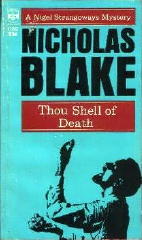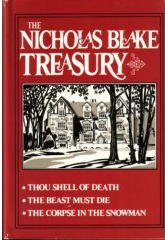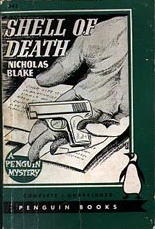Sun 15 Jun 2008
Archived Review: NICHOLAS BLAKE – Thou Shell of Death.
Posted by Steve under Authors , Characters , Reviews[14] Comments
NICHOLAS BLAKE – Thou Shell of Death.
Berkley F1002; paperback reprint, 1964. Hardcover first edition: Collins Crime Club (UK), 1936. US hardcover first edition: Harper & Brothers, 1936, as Shell of Death. [Reprinted in The Nicholas Blake Treasury (Volume 1), Nelson Doubleday, 1964, containing: Thou Shell of Death; The Beast Must Die; and The Corpse in the Snowman.] Other US paperbacks: Penguin, US, 1944, as Shell of Death; Perennial, US, 1977, as Thou Shell of Death.

Even though they have the same author — Nicholas Blake — what a night and day difference there is between this book and the previous one by him, reported on here. This is the second mystery Blake wrote — the first was A Question of Proof — and it’s the second appearance of Nigel Strangeways as well.
The conventions of the Golden Age of Detection are very much evident in this earlier book — complete with anonymous threatening letters, a call for assistance from the recipient, an aging but still engaging ex-flying hero of the previous war, a house party at Christmas time with all of the possible suspects in attendance.
And then death strikes. Is it suicide? Only one set of footprints are found in the snow leading to the small hut where Fergus O’Brien’s body is found.
Or is it murder? Strangeways’ deductions soon answer the question in positive fashion, solving as he does the “locked room” aspect of the case in quick order. By that I mean by page 72, out of a total of 192. (Paperbacks were thin and the print was small, back in 1964.)
But I digress. More mysterious doings occur, all of them complicating the mystery even more, rather than clearing them up at all. It is all rather fascinating and interesting and static until (a) Nigel takes a quick trip to Ireland to uncover some facts about the past, and (b) he returns to Dower House only to find himself falling in love with one of the possible suspects, regretting greatly that his prior hypotheses made her one of the primary ones, in the eyes of Scotland Yard.

As a detective, Nigel himself seems to be only an amateur, in the finest sense of the word. He is called upon in this instance due to the fact that his uncle, Sir John Strangeways, is an Assistant-Commissioner of Police. This allows the dilettantish Nigel to conduct his investigations with the full cooperation of the authorities, if not their down-right awe and admiration.
I’m not sure that dilettante is precisely the right word. From the Internet comes the following definition: a dabbler: an amateur who engages in an activity without serious intentions and who pretends to have knowledge. Nigel Strangeways is serious all right, and he puts the pieces of the puzzle in excellent fashion.
If the early Ellery Queen took after Philo Vance, then I believe that Nigel Strangeways follows in the same footsteps as that very same Ellery Queen, whether directly or in parallel — I have no way of knowing whether Cecil Day-Lewis ever read any of the Queenian adventures or not, but they’re cut from the same cloth, no doubt about it.
As for the case in hand, inspired by a 17th century work by a playwright not previously known to me, Cyril Tourneur, who published The Revenger’s Tragedy in 1607. [NOTE: See Al Guthrie’s comment.] The title of Blake’s work, Thou Shell of Death, comes from a direct quote, which I dare not repeat, for fear of, um, forsooth, revealing too much.

It takes Nigel the entire last chapter, eighteen pages (small print), to untangle all of the twisted threads of the plot, remarking once on a remarkable (well, yes) coincidence that made the killer’s plan succeed the way that it did, not mentioning the much huger one that initiated the entire sequence of events in the first place.
That, plus the entire sheer unlikelihood of anyone plotting such a strikingly complex, ingenious, and therefore inept scheme in the second place — well, that’s simply the joy of author trying to outwit reader that makes the reading — and the challenge — all the more pleasurable.
Blake’s own career, as seen by the earlier post on this blog, eventually went in other directions, as did Ellery Queen’s in tandem. But which kind of story was better, and which are they better known for today? You tell me.
—
June 16th, 2008 at 8:11 am
Must, must, must read this. Incidentally, The Revenger’s Tragedy is widely attributed to Thomas Middleton these days.
June 16th, 2008 at 9:27 am
Al
I appreciate the update. Thanks! I’ve added a link to the play’s Wikipedia’s page, where the controversy is covered in detail. It’s fascinating reading, and you’re right. It looks like Middleton is well ahead on points.
Best
Steve
June 16th, 2008 at 10:33 am
Now that we’ve moved away from these complicated denouements, they are fun to read. When every book ended like this, it may have been tedious, but now it’s charming to see the trouble the author has gone to to entertain readers.
June 16th, 2008 at 10:55 am
Patti
I think you’re onto something there. I like both hard-boiled detectives and the Golden Age approach, for example, as well as a dash of everything else, including cozies.
A steady diet of just one type of mystery and detective fiction would be awfully hard to take, or it would for me.
But even if you like books with complicated endings to the exclusion of everything else, you’ve got to keep in mind that not every author could pull it off very well.
Authors like Blake, Innes, Christie and Carr weren’t considered masters without a reason.
— Steve
June 16th, 2008 at 11:53 am
Blake was a 1930’s mystery reviewer. Several quotes from his reviews praising Agatha Christie books have surfaced as blurbs. It seems likely he read Ellery Queen in the course of his duties.
In the 1950’s, EQ used the title of Blake’s novel “Malice in Wonderland”, to re-title a Rufus King short story in EQMM. He got official permission to do this, either from Blake or his reps.
June 16th, 2008 at 12:15 pm
Mike
I’d surely like to read some of Blake’s reviews. They ought to be very interesting.
— Steve
June 18th, 2008 at 3:31 pm
By one of those coincidences we all agree to swallow if the rest of the story rattles along convincingly, not one, but two, productions of The Revenger’s Tragedy have recently opened over here in England. To mixed reviews, I have to say, though most critics have found something or somebody to praise in each, and there’s been widespread agreement that the play itself is definitely worth its revivals – but to be avoided, presumably, by anyone planning to read Thou Shell of Death!
June 19th, 2008 at 11:30 am
Martina —
My guess is that the play’s all but unknown in this country. Unless I’m the only one who’s not in the know — which could very well be the case! — I don’t think there are many revivals current or pending here in the US.
Here’s a question that occurred to me after reading your last line. When Blake wrote the book, would it have been under the assumption that most everyone reading it would also be familiar with the play?
— Steve
June 19th, 2008 at 7:27 pm
Not sure exactly how familiar the general readership would be, Steve, but The Revenger’s Tragedy is certainly a seminal text. In fact it was a set text on the A-level English syllabus in the early 80s.
June 19th, 2008 at 10:49 pm
Steve, You wrote:
“When Blake wrote the book, would it have been under the assumption that most everyone reading it would also be familiar with the play?”
My gut feeling (I wasn’t actually around at the time!) is to say No, in fact quite the opposite.
If The [London] Times is to be believed, a student production of the play at Cambridge in spring 1937 was the first time it had been staged in 330 years.
It had been in print and read and studied (and admired) during all those years, but only by those with a strong interest in Jacobean drama — say, Eng Lit students, academics and critics.
(The Cambridge revival doesn’t seem to have been much of a success. The Times’s critic makes it clear the middle class English actors spoke the verse jolly nicely but were much too embarrassed to convey lust, jealousy, treachery, hate and all the other high Italian passions that drive the play. Think “The Godfather” remade as one of those stiff upper lip British war movies!)
There were a few more amateur or semi-pro productions in the early 1950s, but it was only with a hugely successful 1965 production by the Royal Shakespeare Company at Stratford that it finally made it into the mainstream (my father saw it, still remembers being knocked out by it).
So, no: Blake needed money pretty desperately in those days and must have known that the title and its origin would have meant nothing to most of his target readers (for all his displays of learning and love of quotation he wasn’t of the Michael Innes donnish school).
In fact, in its enthusiastic review of Thou Shell, The Times (again!) drew attention to: “the title of the novel itself, the significance of which only a reader as well-read and intelligent as Starling will guess.”
Incidentally, I’ve just noticed that the book was published almost exactly one year before that first Cambridge production.
Could it be that Blake’s novel stirred someone’s interest at Cambridge and so led to the eventual re-establishment of the play on stage?
Cultural masterpiece owes revival to mystery genre writer! Way to go!
Cheers
Martina
June 20th, 2008 at 5:52 am
Fascinating! Thanks, Martina.
You might want to check out the Alex Cox movie, Steve. ‘Revenger’s Tragedy’, 2002, set in a post-apocalyptic Britain with Christopher Ecclestone and Eddie Izzard.
http://www.amazon.com/Revengers-Tragedy-Fraser-Ayres/dp/B00027JYEY
June 20th, 2008 at 9:30 am
My advice to myself: watch the movie (description below) and read the book again…
— Steve
Product Description
“He Who Seeks Revenge Should Dig Two Graves”
Alex Cox’s new film is a scathing black comedy about love, sex, family, murder, incest and revenge, set in a post-apocalyptic Liverpool. After ten years in hiding, Vindici (Christopher Eccleston-28 Days Later, The Others) returns to destroy the Duke (Derek Jacobi-Gosford Park, Gladiator) who murdered Vindici’s wife on their wedding day. During his absence Vindici’s family fell into poverty, while the Duke, Duchess and their decadent sons acquired wealth and power, ruling over their court obsessed with transient beauty, money, inherited privilege and power. Determined to exact his revenge, Vindici sets out to gain the confidence of the Duke and his villainous heir, Lussurioso (Eddie Izzard-Dressed To Kill, Circle).
Featuring brilliant performances by Eccleston, Izzard, and Jacobi, Revengers Tragedy proves once again that Alex Cox (Repo Man, Sid & Nancy) is one of the few truly subversive filmmakers at work today. Somewhere between A Clockwork Orange and Baz Luhrmann’s Romeo & Juliet, this updated telling of Thomas Middleton’s notorious 17th century play is an energetic and stylish masterwork.
June 21st, 2008 at 11:08 am
BTW, a Google search for Nicholas Blake threw up a result from Google Books, a reference to a book called Re-charting the Thirties edited by Patrick J Quinn. It contains essays on various English writers of the period, including an interesting one on C Day Lewis that looks at his 1930s Nicholas Blake novels (Thou Shell.. among them).
Surprisingly for so recent a publication (1996), the whole essay is readable on-line, at
http://books.google.com/books?id=9AtgeckHXYAC&printsec=frontcover&dq=recharting&sig=HB-JAl_eFcKscCNmtZYbKt_DSoM#PPA146,M1.
Martina
January 24th, 2009 at 4:44 pm
I suppose I get stuck mentioning the obvious — namely that aside from being Nicholas Blake, Cecil Day-Lewis was the official poet laureate of England and the father of actor Daniel Day-Lewis.
He based his amateur sleuth Nigel Strangeways on his friends and fellow poets W.H.Auden and T.S. Eliot. Strangeways was married to the explorer Georgianna Strangeways in the early books, but she dies after the war and Strangeways hooks up with and travels with an attractive widow.
Certainly the best known of the books is The Beast Must Die that became the classic French suspense film This Man Must Die (about a father determined to avenge the hit and run death of his son — Strangeways didn’t appear in the movie version). I seem to recall Beast being adapted on American radio with Herbert Marshall doing Strangeways, but I may be wrong.
In any case the Blake books are well worth rediscovery, both the two non Strangeways novels and all the series entries. Of the post war books The Widow’s Cruise is a standout. Smiler With a Knife is a pre war thriller in which Georgianna Strangeways goes undercover to rout home grown fascism, Nigel only has a minor role, and at least one of the post war novels is cold war thriller involving Strangeways in espionage. The Corpse in the Snowman features a character based on T.E. Lawerence who Day-Lewis knew.
All the books are literate and well written, and Blake made the transtion from the more formal classic mystery of the Golden Age to the more character driven works of the post war era smoothly.